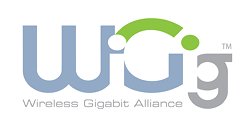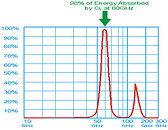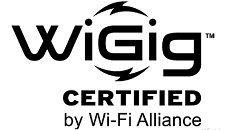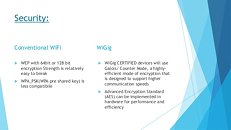Wednesday, October 26th 2016

Wi-Fi Alliance Begins Certification Process for Wi-Fi CERTIFIED WiGig
Wi-Fi Alliance, the nonprofit organization that promotes Wi-Fi technology and certifies the interoperability of different Wi-Fi products, has announced that it has begun the certification process for the Wi-Fi CERTIFIED WiGig, otherwise known as the 802.11ad standard - a complement to the higher-range ac standard currently emplyed. WiGig is sure to stir the wireless ecosystem, in that it brings to the table multi-gigabit speeds - up to 8 Gb/s - with low latencies. because of that, this technology is sure to see widespread adoption - due to it allowing wireless connections with data rate characteristics close to wired ones, it might be the first step towards wireless VR and AR experiences, with more applications in the area of wireless docking, multimedia streaming, gaming, and networking. According to a 2013 survey from ABI Research, the 60 GHz Wi-Fi chipset market is forecasted to be worth more than $1,500 million until 2018.WiGig devices use beamforming to focus a directed signal between devices, to eliminate interference from nearby devices and to enable high performance even in dense 60 GHz environments. It uses wider channels in 60 GHz to transmit data efficiently at multi-gigabit per second speeds and with low latency at distances of up to ten meters. The downside to this technology is that at a frequency of 60 GHz, signal interference becomes a much greater problem than at the usual (and saturated) 2.4 and 5 GHz frequencies. For example, at WiGig's frequency of 60 GHz, atmospheric O2 strongly absorbs microwave radiation (which is why this frequency is not usable for long-distance communications) due to a molecular resonance. The absorption at this 60 GHZ frequency is very high, with 98 percent of the transmitted energy being absorbed by atmospheric oxygen. While this oxygen absorption at 60GHz severely limits range, it also eliminates interference between same frequency terminals.Though it is a shame that this technology has such a short range of action, with walls severely limiting its multi-room usage with a single antenna, the truth is this also has an upside: security. This combination of oxygen absorption and narrow beam transmission enhances the security of the 60GHz radio link, minimizing the probability of unauthorized interceptions. One can effectively devise a closed-access network operating in a single room, since the Wi-Fi signal simply doesn't reach the exterior of the room's walls. This makes this technology extremely interesting from not only an end-user standpoint, but also from a security perspective. Adding to that the revised and improved WiGig security protocols, and this platform is sure to fill some application niches the current standards aren't able to cover.In its news blog, the Wi-Fi Alliance states that "Wi-Fi Alliance certification has a strong history of accelerating broad technology adoption across the industry, and we expect 2017 to be a breakout year for WiGig on the heels of Wi-Fi Certified program availability," said Phil Solis, Research Director, ABI Research. "The ecosystem for WiGig spans the mobile, PC, and consumer electronics industries across the consumer, enterprise, and service provider markets. Devices will leverage the brand and ubiquity of Wi-Fi for continued momentum across these industries."
Multi-band Wi-Fi CERTIFIED products supporting 2.4, 5, and 60 GHz allow handoff between frequency bands, selecting the most appropriate band and data rate for the application and surrounding environmental conditions, with WiGig devices ranging from smartphones to portable PCs, tablets, access points, home entertainment and consumer electronics. ABI Research forecasts 180 million WiGig chipsets will ship to the smartphone market in 2017, with smartphone chipsets accounting for almost half of the 1.5 billion total market shipments in 2021. And as part of the Wi-Fi ecosystem, WiGig delivers the highest level of security, with multi-band devices interoperating with more than eight billion already-deployed Wi-Fi products.
Source:
Wi-Fi Alliance
Multi-band Wi-Fi CERTIFIED products supporting 2.4, 5, and 60 GHz allow handoff between frequency bands, selecting the most appropriate band and data rate for the application and surrounding environmental conditions, with WiGig devices ranging from smartphones to portable PCs, tablets, access points, home entertainment and consumer electronics. ABI Research forecasts 180 million WiGig chipsets will ship to the smartphone market in 2017, with smartphone chipsets accounting for almost half of the 1.5 billion total market shipments in 2021. And as part of the Wi-Fi ecosystem, WiGig delivers the highest level of security, with multi-band devices interoperating with more than eight billion already-deployed Wi-Fi products.





7 Comments on Wi-Fi Alliance Begins Certification Process for Wi-Fi CERTIFIED WiGig
This has a few very specific uses and that's it.